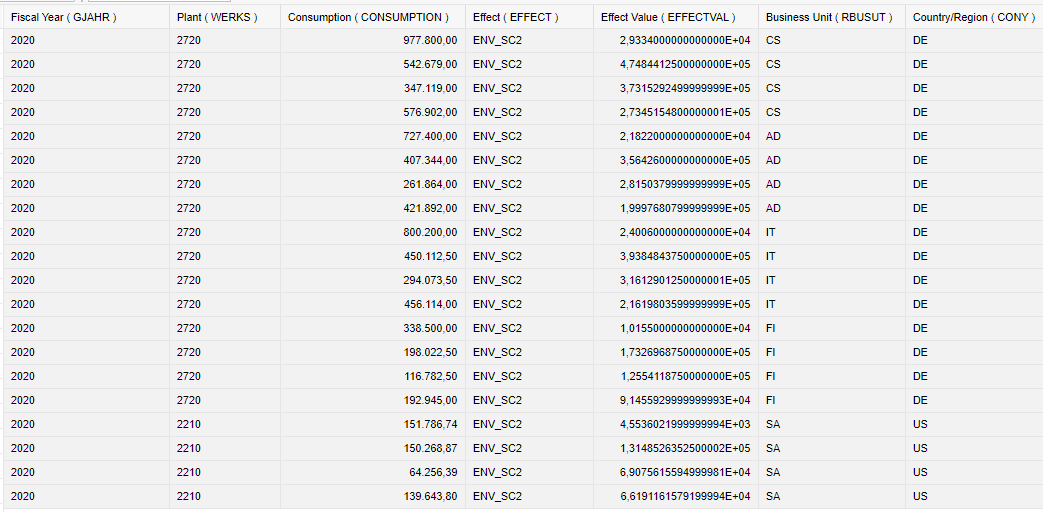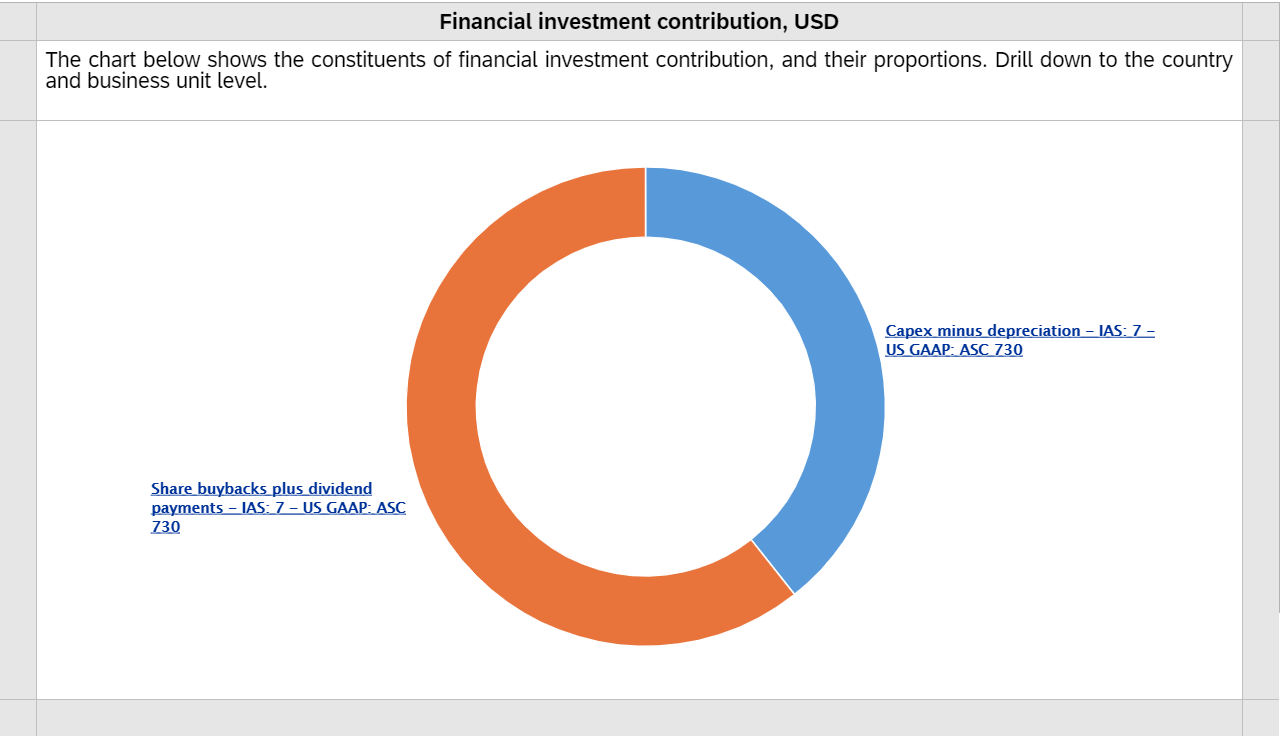
- SAP Community
- Products and Technology
- Financial Management
- Financial Management Blogs by SAP
- Reporting Frameworks: The Case of Stakeholder Capi...
- Subscribe to RSS Feed
- Mark as New
- Mark as Read
- Bookmark
- Subscribe
- Printer Friendly Page
- Report Inappropriate Content
Dear sustainability enthusiasts as well as experts and followers of SAP Profitability and Performance Management, my name is Olga, and in my blog post I’d like to introduce the implementation of WEF’s Stakeholder Capitalism Framework in SAP Profitability and Performance Management on- premise as part of the Value Chain Sustainability Sample Content. Having worked with SAP Profitability and Performance Management for about a year now, I’ve gained experience around various functions of this product to answer corresponding business needs. One of such most popular business needs concerns sustainability topics, in particular, how to incorporate the WEF’s Stakeholder Capitalism Metrics (SCM) framework into a company’s sustainability reporting. Let me give you a background to the initiative of this sustainability reporting framework by the World Economic Forum (WEF) and walk you through its possible implementation in SAP Profitability and Performance Management on-premise.
Understand Stakeholder Capitalism for Sustainability
The context in which businesses operate has been changing very dynamically over the last few years. These changes were driven by environmental factors like climate change and nature loss, social factors such as diversity and the need to improve working conditions as well as economic factors including shifting market demands and new laws and regulations. It became apparent that nowadays, in order to create long term value, companies cannot focus solely on the interests of their shareholders, but have to orient themselves to serve interests of all stakeholders, thus adopt an approach called “stakeholder capitalism”.
Stakeholder capitalism is based on five main principles:
- to change the mindset of the board from being focused on shareholders to the focus on stakeholders
- to set and track environmental goals
- to improve the sense of responsibility for consumers, suppliers, and their employees
- to serve consumers’ long-term needs
- to treat employees with respect and invest in their future
The Stakeholder Capitalism Metrics (SCM) was initiated and published by the International Business Council of the World Economic Forum in collaboration with: Bank of America, Deloitte, EY, KPMG, and PwC in 2020, with the aim for companies to report on key dimensions of sustainable value in a consistent and more comparable way. This reporting framework is based on and points references to the existing sustainability standards and frameworks such as Global Reporting Initiative (GRI), Sustainable Development Goals (SDG), Sustainability Accounting Standards Board (SASB) and others. The SCM consists of 21 core and 34 expanded metrics and disclosures, and is divided into four pillars: Principles of Governance, Planet, People and Prosperity:

(Source: http://www3.weforum.org/docs/WEF_IBC_Measuring_Stakeholder_Capitalism_Report_2020.pdf)
The core metrics are those ESG metrics which are well-established in practice and are already being reported, though in different formats. The expanded metrics are less established among firms and contribute to ESG reporting in a more advanced way. More information on the WEF’s Stakeholder Capitalism Metrics can be found here: https://www.weforum.org
The Stakeholder Capitalism Metrics framework (SCM) is recommended to be included in companies’ annual reports and proxy statements. Multiple industries and companies have announced their commitment to report on the Stakeholder Capitalism Metrics. Currently this number of companies who committed to report on SCM is over 70, and it is constantly growing.
Implement WEF’s Stakeholder Capitalism Metrics in Value Chain Sustainability Sample Content of SAP Profitability and Performance Management
As mentioned above, the SCM is divided into four pillars: Principles of Governance, Planet, People and Prosperity. We focused on all 21 core and 12 expanded metrics and disclosures, but with further releases the included metrics might be enhanced.
The quantitative metrics and related KPIs are calculated by means of various functions of SAP Profitability and Performance Management; the qualitative metrics can be added to the report as corresponding description texts. An example of the structure and reporting on qualitative and quantitative SCM metrics and related KPIs can be found in Reports view of the Value Chain Sustainability Sample Content:


So, let’s start with data sources and see how we used it to calculate stakeholder capitalism metrics related KPIs. We created several model tables with data, similar to the ones a company would keep, such as corporate master data, business partners data, corporate purchase and sales data, data on travel, inventory and facilities consumption, other environmental data, social and governance data, etc. I wouldn’t provide here the description of all functions and calculations that were used but give you some examples to wake your appetite.
Data models for facilities/ travel/ vehicles consumption inventory
These data models store sample data necessary to further calculate GHG emissions. The data covers electricity consumption, heating consumption, travel distances, type of the vehicle, etc. With a Derivation function, we derive Scopes of GHG emissions (Scope 1, Scope 2 and Scope 3). The Allocation function helps us to allocate carbon emissions according to the factors that each energy source type has. The data after Derivation and Allocation can be already used for GHG emissions analysis according to various company dimensions such as plant, country/region or business unit:

Data model with reporting standards
Because the Stakeholder Capitalism Metrics framework is the collection of most significant and commonly used sustainability metrics, it refers to various reporting standards this metric was based on. Such reporting standards can be Global Reporting Initiative (GRI), Sustainability Accounting Standards Board (SASB), International Accounting Standards (IAS) and more. Thus, a company would have a holistic view of sustainability metrics and reporting standards they are based on:

If needed, these reporting standards can be used in dashboards and visualizations, e.g. :

Data model to maintain anti-corruption training data for business partners
This data model has a different from the previous ones, but simple structure – a list of vendors and customers and a “yes” or “no” entry for completion of anti-corruption training:

Because we need to calculate percentages of business partners who received an anti-corruption training and combine this data with other related SCM metrics, we use a Join function, where we can also calculate the percentage (e.g. as AVG*100), and using various rules for union or left outer join we combine the data according to the wished results.
Conclusion
The Value Chain Sustainability model is comprehensive and compatible with various reporting standards and frameworks. The WEF’s SCM is only one example how sustainability standards can be incorporated into this model, but even at the current development status you might see that Value Chain Sustainability includes a lot of parts, such as EU Taxonomy, Input-Output model, WEF’s Stakeholder Capitalism Metrics, etc.:

Stay tuned as my colleagues are going to cover further sustainability topics, modelling challenges and solutions.
I hope with this blog post, I woke your interest in the reporting framework of Stakeholder Capitalism Framework by the World Economic Forum as well as various possibilities for calculations and reporting you can leverage with SAP Profitability and Performance Management. You might have noticed that I listed quite a number of metrics that we implemented, and for these metrics the various data is used and calculated so that at the end we can have a holistic view of all necessary metrics and possibilities for their deep analysis.
If you enjoyed reading this blog post, you might notify it by clicking the Like button. You are very welcome to comment and ask questions, write your recommendations and suggestions for the SAP Profitability and Performance Management topics that are interesting and useful to you, and I will do my best to fulfil your appetite for knowledge.
Thank you and see you soon!
- SAP Managed Tags:
- SAP Profitability and Performance Management,
- Sustainability
You must be a registered user to add a comment. If you've already registered, sign in. Otherwise, register and sign in.
-
Business Trends
145 -
Business Trends
15 -
Event Information
35 -
Event Information
9 -
Expert Insights
8 -
Expert Insights
29 -
Life at SAP
48 -
Product Updates
521 -
Product Updates
63 -
Technology Updates
196 -
Technology Updates
11
- GRC Tuesdays: Takeaways from the 2024 Internal Controls, Compliance and Risk Management Conference in Financial Management Blogs by SAP
- GRC Tuesdays: Insights into Cybersecurity Supply Chain Risk Management: Why, What and How in Financial Management Blogs by SAP
- Manoeuvring Through the Complexity of EU Sustainable finance: Corporate Sustainability Reporting Directive (CSRD) in Financial Management Blogs by SAP
- SAP Signavio for Governance, Risk and Compliance (GRC) in Financial Management Blogs by SAP
- GRC Tuesdays: Latest Trends in Governance, Risk, and Compliance Technology in Financial Management Blogs by SAP
| User | Count |
|---|---|
| 3 | |
| 2 | |
| 2 | |
| 2 | |
| 2 | |
| 1 | |
| 1 | |
| 1 | |
| 1 | |
| 1 |